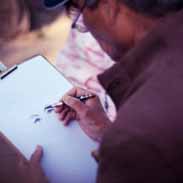mycology study guide
Unlock all answers in this set
Unlock answersquestion
Microsporum audouini
answer
produces antler and raquet shaped hyphae; fluorescent with woods lamp
question
trichophyton mentagrophytes
answer
produce perpendicular peg-like invasion of hair shaft
question
rhizopus
answer
produce rhizoids
question
aspergillus fumigatus
answer
produce opportunistic infection in neutropenic patients
question
cryptococcus neoformans
answer
turns brown on birdseed agar, budding yeast; capsules stained with india ink
question
histoplasma capsulatum
answer
yeast cells may be seen within monocytes and macrophages
question
microsporum gypseum
answer
produce rough, thick walled, spindle shaped macroconidia; hair and skin infection
question
candida albicans
answer
produce in germ tube in 3 hours. blastoconidia, hyphae, pseudophyphae.
question
epidermophyton floccosum
answer
"Beaver tail" macrocondia
question
paracoccidiodes brasiliensis
answer
produce "mariners wheel", "lollypop" or "mickey mouse" budding yeast at 37 degrees C
question
sprothrix schenckii
answer
"daisy head" flowerettes, rose gardeners disease, nodules along infected lymph ducts
question
fonsecaea
answer
"cauliflower" like skin lesions, dark septte hyphae, primary, secondary, tertiary
question
coccidioides immitis
answer
inhaled barrel shaped arthoconidia
question
trichophyton tonsurans
answer
endothrix hair invasion
question
pseudallescheria boydii
answer
hyaline, septate hyphae, produce cleistothecia (closed) sacs filled with ascospores
question
blastomyces dermiditis
answer
yeast in tissue produce large double contoured walls
question
trichophyton rubrum
answer
red pigment on potato dextrose agar
question
phialophora verrucosa
answer
produce subcutaneous chromoblastomycosis
question
pneumocystis jiroveci
answer
cyst cell walls found in bronchial samples stain black or fluoresce w calcofluor white
question
geotricum
answer
from arthoconidia singly or in chains or branched
question
protozoa
answer
eukaryotic and unicellular
question
protozoa multiply this way
answer
binary fission
question
throphozoites are
answer
motile, reproducing, feeding, lower GI tract; ID'd by nuclei, size, inclusions and motility
question
cyst stage is
answer
non-feeding, non-motile, infectious stage; ID by nuclear structure, size shape, # of nuclei, inclusions
question
entamoeba histolytica causes
answer
amebic dysentery
question
E. histolytica cysts have how many nuclei
answer
1,2 or 4, cigar shaped chromatoid body are central and have bull-eye karysome
question
E. Histolytica trphozoites have how many nuclei
answer
only one, may have residual red cell in nucleus
question
entamoeba hartmanni cyst have how many nuclei
answer
1,2 or 4 with central karyosome, chromatoid body
question
Entamoeba coli cyst has how many nuclei
answer
1-8 nuclei eccentric karyosome, splinter shape chromatin
question
Giardia lamblia trophozoite
answer
2 nuclei, median body, suckling disk, 8 flagella, axonmes, falling leaf motility
question
giardia lamblia cyst
answer
up to 4 nuclei
question
trichomonas vaginalis throphozites
answer
single nuclei, 4 anterior flagella, axostyle, undulating membrane
question
trichomonas vaginalis cyst
answer
no cyst form
question
trypanosoma cruzi causes
answer
chagas disease, ruduviid bug bite, then infects with feces
question
diagnostic stages of T. cruzi in humans
answer
amastigote stage in muscle and trypomastigote form in blood with terminal kinetoplast
question
plasmodium sp. (malaria)
answer
members of sporozoa, from mosquitoes, obligate endoparasitic protozoa, non-motile, ID by trophozoites, schionts and gametocytes in blood, thick and think smears used
question
plasmodum vivax
answer
48 hour paroxysmal cycle, schuffners dots, 12-24 merozoites, gamete fill cell
question
plasmodium falciparum
answer
malignant malaria, irregular life cycle, small delicate, double chromatin dots, crescent shaped gametocyts
question
plasmodium malariae
answer
72 hour cycle, band form of trophozoite, 8 "daisy-petal" merozoites in schizont
question
plasmodium ovale
answer
red cell has fringed edge, schuffners dots, resembles P. vivax
question
toxoplasma gondii
answer
reside in cats, dangerous if crosses placenta, crencent shaped bradyzoites in body fluid, inactive cyst in muscle
question
crytosopridum parvum
answer
attatches to intestinal mucosa and invades host, small; confused with yeast or RBC, fluorescent staining, think milwaukee
question
cyclospora cayetanensis
answer
important to differentiate from c.parvum, acquired from imported fruits and veggies, immature oocysts found in feces
question
dematiaceous hyphae
answer
darkly pigmented due to presence of melanin in the cell wall
question
hyaline hyphae
answer
non-pigmented or light
question
diamorphic fungi
answer
either yeast or mold from depending on growth environment, mold room temp and yeast at 37 degrees C with CO2
question
class zygomycetes
answer
mucor and rhizopus, aseptate, produce asexual sporangiospores or sexual zygospores
question
class ascomycetes
answer
produce sexual ascopores, or asexual condida, includes; microsporum, trichophyton, and pseudoallescheria
question
class basidioycetes
answer
mushrooms, puff balls; usually non-pathogenic; include crytpcoccus neoformans
question
class duteromycetes
answer
imperfect; no sexual form, common human pathogen causing cutaneous, subcutaneous, and systematic disease
question
KOH prep
answer
10% KOH on glass slide add heat, skin, nail, hair. breaks down keratin so fungi can be seen. add (dimethyl sulfoxide) no heat reaquired
question
calcofluor white stain
answer
chitin, cellulose in cell walls of funi bind to calcoflur white stain; fluoresces blue-white to apple green under UV light
question
lacto-phenol cotton blue prep
answer
lactic acid preserves fungal structures, phenol kills fungus, and gotton blue stains fungus
question
india ink prep
answer
provides black background for encapsulated organisms, equal volume of stain and CSF, used on cyptococcus neoformans
question
sabourauds dextrose agar
answer
w or w/out anibiotics, all purpose, high sugar and pH (5.7); cycloheximide addes to inhibit growth of environmental fungi, gentamicin/chloramphenicol inhibit bacteria
question
brain heart infusion agar with blood
answer
used for fastidious fungi, room temp
question
potato dextrose agar
answer
potato infusion with destrose, special media used for pigment production
question
cornmeal agar w/tween 80
answer
chlamydospore formation by c. ablicans, use coverslip
question
chromogenic agar
answer
C. albicans=green C. tropicalis=metallic blue C. krusei=rose
question
trichophyton agars 1-7
answer
T1 agar- no thiamine T4 agar- rich in thiamine T. tonsurans requres thiamine to grow so no growth on T1 agar
question
media used to identify dermatophytes
answer
potato dextrose agar
question
4 types diamorphic fungi
answer
blastomyces dermatidis, paracoccidiodomysis brasilersis, histoplasma capsulatum and coccidiomycosis immitis



